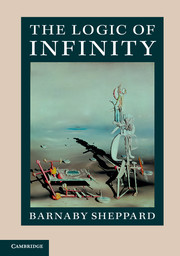Book contents
- Frontmatter
- Contents
- Preface
- Synopsis
- 1 Introduction
- 2 Logical foundations
- 3 Avoiding Russell's paradox
- 4 Further axioms
- 5 Relations and order
- 6 Ordinal numbers and the Axiom of Infinity
- 7 Infinite arithmetic
- 8 Cardinal numbers
- 9 The Axiom of Choice and the Continuum Hypothesis
- 10 Models
- 11 From Gödel to Cohen
- A Peano Arithmetic
- B Zermelo–Fraenkel set theory
- C Gödel's Incompleteness Theorems
- Bibliography
- Index
8 - Cardinal numbers
Published online by Cambridge University Press: 05 August 2014
- Frontmatter
- Contents
- Preface
- Synopsis
- 1 Introduction
- 2 Logical foundations
- 3 Avoiding Russell's paradox
- 4 Further axioms
- 5 Relations and order
- 6 Ordinal numbers and the Axiom of Infinity
- 7 Infinite arithmetic
- 8 Cardinal numbers
- 9 The Axiom of Choice and the Continuum Hypothesis
- 10 Models
- 11 From Gödel to Cohen
- A Peano Arithmetic
- B Zermelo–Fraenkel set theory
- C Gödel's Incompleteness Theorems
- Bibliography
- Index
Summary
Cardinal theorems and Cantor's paradox
We all have a tendency to think that the world must confirm to our prejudices. The opposite view involves some effort of thought, and most people would die sooner than think – in fact, they do so.
–Bertrand RussellThe Cantor-Bernstein Theorem
At the centre of the theory of cardinal numbers is the notion of equipollence of sets and critical in the application of equipollence is the Cantor-Bernstein Theorem.
The Cantor-Bernstein Theorem
If a set x is equipollent to a subset of a set y and if y is equipollent to a subset of x then x is equipollent to y.
The Cantor–Bernstein Theorem is intuitively highly plausible. One might even mistakenly think that it is obvious, based on an extrapolation from the trivial finite case. However, a glance at its history reveals that the route to full understanding was not smooth; the transparent proofs known to us today make it very easy for us to forget these early difficulties.
Cantor first conjectured in 1882, and a year later proved, the theorem in the special case of subsets of ℝn, however, he assumed the Continuum Hypothesis in the proof. Over the next twelve years Cantor was to share his conjecture with several sources. The proofs Cantor outlined in this period assumed the Well-Ordering Theorem. Developments over the remaining part of the nineteenth century gradually stripped away these further assumptions.
- Type
- Chapter
- Information
- The Logic of Infinity , pp. 319 - 334Publisher: Cambridge University PressPrint publication year: 2014



